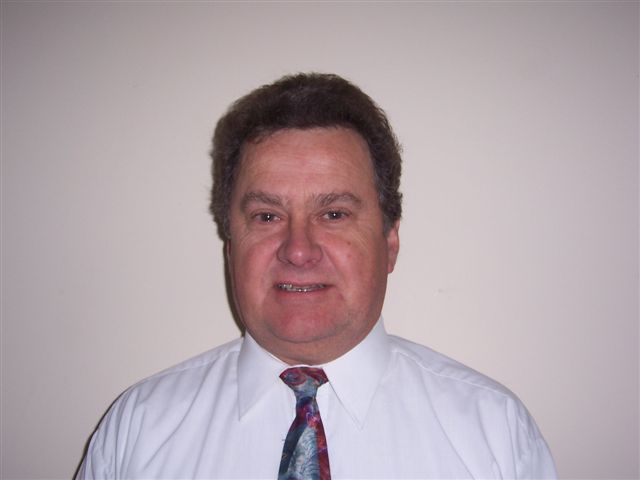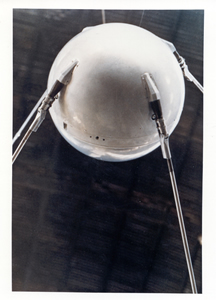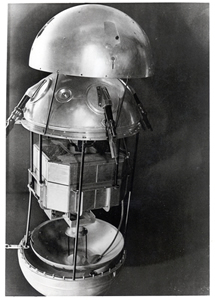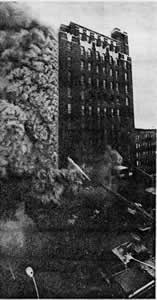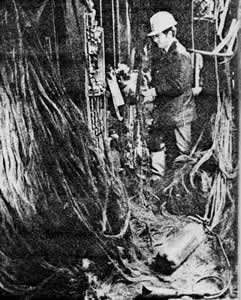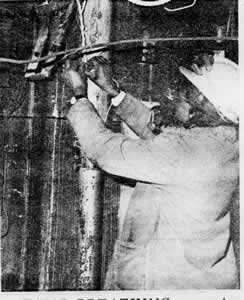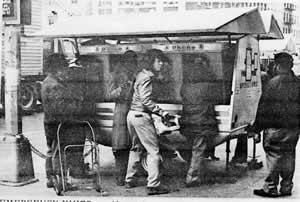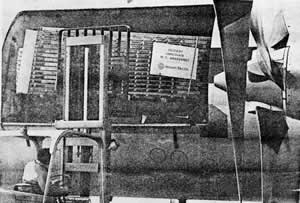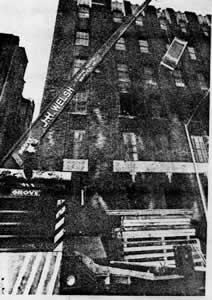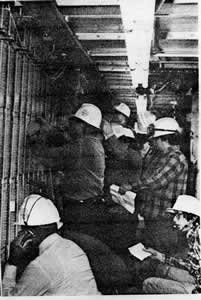OTVA NEWSLETTER - May 2008 - Volume 10 - Page 15.
CONTENTS (Click on
page number) NSW AGM – 13 JUNE 2008 Kurrajong Radio Museum - 13th or 14th
September, 2008 (www.vk2bv.org/museum). END OF YEAR FUNCTION - Mid November OTVA (VICTORIAN BRANCH) 51ST AGM- Thursday
29th May. FUTURE OUTINGS PRESIDENT’S
MESSAGE Well it is now almost 12 months since you elected me to the position of President of the OTVA and it is once again time for you to attend the AGM and vote in a team that can enthusiastically greet the challenges of the next 12 months to further promote the OTVA and address the requirements of its members. It has been a year of disappointment mixed with many highlights. The passing of a dozen or so of our members or their spouses is of course a disappointment but it is our challenge to not dwell on their passing but to celebrate their lives through the memories that they have left behind. To this end Bob Lions has continued to produce a Newsletter each and every quarter that is full of interesting stories and informative pictures. The Newsletter has been the source of stimulation and nostalgia over many years under Bob’s significant editorial prowess. The OTVA web site has progressed in leaps and bounds thanks to the initial work of Joe Collister and over the past year Chris Bull. Chris has loaded all of the past Newsletters and developed a means whereby members can search those issued over the past 10 years looking for specific stories or articles of interest to members. The information on the web site has been securely partitioned to maintain the confidentiality of the information retained within those Newsletters which may be easily misunderstood if viewed by someone without an understanding of OTC and the characters who made it great through their efforts and their personalities. The Executive of the OTVA continues to grapple with the issues relating to the display and storage of the large amount of OTC memorabilia. The Telstra Museum at Bankstown is the repository for most of the archived equipment and materials with some significant items in the possession of the Power House Museum. Telstra will be moving the entire contents of the Museum to a new site in the not too distant future. Our challenge will be to work with Telstra to ensure that the OTC archives are preserved for the future. The Executive has sought input from the OTVA membership in regards to the method of delivery for future Newsletters through the survey that was distributed with the last Newsletter. Your responses are being collated for consideration by the Executive so as to better improve the balance between the effective delivery of information to our membership and the management of costs. The next social outing is being organised for
the Kurrajong Radio Museum and is dependent upon your responses
so check out the details in this Newsletter and let us know whether
you can make it. I thank each and every member of the Executive for the support that they have given me in the past 2 months and for the effort and dedication that they continue to deliver to the task of providing service to our members. I look forward to seeing you at the AGM on June
13 2008. SOCIAL NOTES [Top] See the events page
for a brief report on the NSW Reunion held in March this year. THE SURVEY [Top] Accompanying the last Newsletter was a survey to see how members would like to receive future issues of the Newsletter. The questions asked are repeated for those who ignored it or forgot to fill it out.
If you would still like to respond you should do so asap. The results, as surveys go, are pretty normal but that is disappointing. Of about 255 recipients we have received some 69 responses (about 27%). Some of the outcomes are reported below. Not surprisingly, most of those who responded by post wanted paper and of those who emailed wanted email. Of those who wanted email, about half would have either. The message is clear that members still want the Newsletter. If it were web based, they would like a notification by email when a new issue was available. Thus there is plenty of food for the committee but if you haven’t responded yet would you do so soon, please?? The following comments were gleaned, members would like to see:
Interim conclusions: (Personal to the Editor as I have only just done my part and collated the email replies received as part of putting this Newsletter together.) It would appear that email distribution should be tried. I would note that previous issues have ranged up to 3.8MB which is no problem to those with broadband but could be a problem for those on dialup. It will have an impact on our postage costs since we will probably lose our bulk postage rate, but we will have far fewer paper copies to print and post. The comments offer a number of avenues for investigation by the committee. However the suggestions for Newsletter items prompt the immediate response of “Why don’t you write one to show how you would like to see others contribute?” Writing this newsletter demands input and as I have said many times before – “Everyone has a story, don’t be coy, put it on paper and send it to the Editor” The results will be sent to the Committee to assist with future planning. There are also prizes for the best articles – let your cupidity drive you! SPUTNIK, THE FIRST ARTIFICIAL EARTH SATELLITE: By Cyril Vahtrick [Top] News of Sputnik's launch came on the Saturday of the October Long Weekend in 1957 and one detail of the announcement caused some OTC people to prick up their ears - Sputnik would be transmitting signals at just over 20 MHz (also 40 MHz). It’s amazing to realize that this was over 50 years ago!
Graham Gosewinckel, then an engineer at OTC's international receiving station at Bringelly, NSW, immediately began to search for the signals and was able to pick them up with a sensitive HF receiver, coupled with suitably chosen rhombic aerials. The satellite's orbital period (96 minutes) entailed some dexterity in keeping track of the signals during the relatively short period when the satellite was over our part of the globe. Graham informed Chief Engineer Bob Long of his discovery and all other OTC receiving stations were alerted including Rockbank Vic. and the Coast radio Station in Hobart which quickly picked up signals and, by comparing signal strengths and times, a pretty good idea of the satellite's orbital period was obtained. Bob was discussing with Cyril Vahtrick the fact that observations indicated that each succeeding satellite orbit seemed to have precessed by some 20 degrees or more westward. Then suddenly it dawned on us - we were of course communicating with an extraterrestrial object - our world was rotating under the orbit of this object. A brief calculation showed that the earth was rotating precisely 24 degrees eastwards per each 96 minute satellite orbit. This meant that the satellite returned to the same relative position over us every fifteenth orbit. On the second day, Hobart Radio telephoned Bob and reported not only signals from the satellite at the predicted time but also an actual sighting of the satellite in the evening sky where it appeared to be the same size as an eighth magnitude star . Since this was the first reported sighting in the world that we were aware of, it became of considerable interest to the whole country. With our by now fairly accurate calculations of the satellite's orbital path (about a 65 degree angle to the Equator) Bob Long decided to contact the news media and forecast that the satellite would be arriving at a precise time in the early evening and that it might be seen in the south western sky over Sydney at that time.
This prediction proved to be accurate and a large number of Sydney people were able to observe the satellite in the sky. As all this happened over the long weekend, there appeared to be nobody available in Government departments or the military to comment on this newsworthy event. As a consequence, it seemed as if the whole media world descended on OTC for information. In fact the normal OTC business seemed almost to come to a standstill for a day or so during the height of interest in Sputnik. We were besieged by calls and as people reported satellite or UFO sightings all over the place, Cyril Vahtrick and Ron Knightley rigged up an orbital indicator on an office globe, with a slide representing Sputnik. By rotating the globe from a known time reference and moving the slide on its fixed orbit we had a reasonably good slide rule which could tell us where Sputnik was at any time. There was one telephone call where a country newspaper reporter had heard that a "flaming object" had plummeted to the ground near a town in western N.S.W. Bob asked him what time this had happened and, with a quick flick of our makeshift orbital calculator Bob solemnly announced that, at that time, Sputnik would have been over Afghanistan! Graham Gosewinckel made many recordings of the bleep, bleep, bleep, coded signals transmitted by Sputnik, quite unintelligible to us or course, but naturally the media wanted recordings to broadcast to the public. One amusing phone call we received was from somebody who declared that he could distinctly hear the Sputnik sounds emanating from his bed springs! On the serious side, we attempted to use the satellite to perform some 20MHz ionospheric propagation tests and to have a general look at our rhombic aerial radiation patterns, but it was difficult to set up other than qualitative tests. OTC's involvement in satellites temporarily receded after Sputnik, with pressures from the real world of HF radio and the exciting prospect of submarine telephone cables which were now on the drawing board. THE MIRACLE ON SECOND AVENUE: by Bob Lions [Top] This is a story I have had tucked away for over thirty years. I heard of the disaster as it was happening from an AT&T colleague to whom I was talking at the time and he was watching a news flash on US television. It appeared in “TELEPHONY” for 14 April 1975. It is the story of heroic efforts by a customer oriented telco which impressed me then and again when I re-read the story recently. In the world of what-if, I wonder at the response of big T, if a disaster like this were ever to happen in Australia. I apologise for the quality of the pictures. These are scans of 30 year old photocopies of a magazine article so there are many areas in which the quality could be degraded. The spelling remains American and you are all old enough to understand the imperial measurements used! I did put in a few metric conversions. Ed.
NEW YORK TEL TRANSFORMS DISASTER INTO TRIUMPH ON FEB. 27, 1975, fire devastated a major New York Telephone Co. switching center, paralyzing phone service in a 300-sq.-block area of Manhattan's Lower East Side. More than 104,000 lines serving 173,000 phones through 12 exchanges were knocked out in what was declared the worst fire disaster in telephone history. Just as spectacular as the fire was the restoration project that followed. It took 21 days of all-out effort by an efficient, coordinated team of workers and suppliers to restore service in "the miracle on Second Ave.," as it was described by Lee Oberst, New York Tel's vice president-New York City region. The fire broke out in a basement vault of the 12-story building where hundreds of thousands of pairs begin a criss-cross route through the first few floors. The basement, first and second floors were hardest hit by the stubborn blaze. Damage to equipment and cables was incredible as the fire burned out of control for 15 hours, crippling 31,000 switching mains, damaging 73,000 other mains and five tandems (trunk exchanges) handling intercity service and trunks into Long Island. One witness, describing the destruction, said, "Cables containing hundreds of wire pairs looked like thick strands of hay, all the plastic insulation had been melted from them. One outgoing trunk testboard that was made of solid mahogany vanished except for the wires and metalwork." As the fire spread through the center, progressing from one-alarm to six-alarm status, the telco launched emergency service and restoration programs. Western Electric, the Bell System's manufacturing arm, and Bell Telephone Laboratories, its research organization, were alerted and soon had representatives at the fire scene, ready to assess the damage and rebuilding job. At 2 a.m., only two hours after discovery of the
fire, a first-draft restoration scheme was completed. Within 12
hours, the final plan was ready and an hour later it was put into
action. Supplier reaction is swift. Even before the blaze was brought under control, Western Electric engineers pulled out installation drawings for the 50-year-old building to determine what equipment might be needed. At Western's northeastern region headquarters in Newark, engineers and detailers, working in shifts, specified equipment to be ordered and methods to be used in installation. Finally, after clearance to enter the building came from fire officials, dozens of engineers and technicians from various arms of the Bell System swarmed over the building, assessing damage and making specific rebuilding plans. Equipment that appeared to have escaped damage was tested, retested and then tested again. Teams 'of Western Electric installers ripped out burned equipment and cleaned up the less severely damaged third through eleventh floors. Working with them was a chemist brought in to concoct and prepare a special solution to remove the baked-on grime from switches.
Meanwhile, some provision had to be made for customers
normally served by the equipment that was burned out. "We had
33,000 customers working from four central offices on the first
and second floors; all panel equipment, completely destroyed,"
reported George Kennelly, New York Tel's assistant vice president-public
relations. "The cable vault and all the equipment in it was
completely destroyed, so there was no chance to restore the four
COs on those floors," he explained. We were confident that all of our suppliers, both large and small, would react as we expected them to. They came through better than we could have hoped. We got the best possible equipment delivered in the shortest possible time." Equipment needs during the 21-day restoration and replacement effort were mind boggling. Components, tools, equipment arrived literally on an hourly basis, including more than 30,000 miles of cable, enough to drape the perimeter of the earth—and then some. Cleaning and restoration equipment arrived from all over the country, parts were delivered by truck, by plane, by helicopter—whatever mode of transportation seemed expedient at the time. One of the earliest decisions by Western Electric was to divert 270 pieces of distributor frame equipment destined for another Bell company, Pacific Telephone. The mainframe, which at that point "was just heaps of steel," according to Kennelly, was held at Western's Hawthorne works in Cicero, Illinois, and was redesigned and reengineered to New York Tel's specifications. The 31,000-lb. frame was shipped to Newark, N.J., in three chartered airfreighters, arriving within 20 hours after the fire was snuffed out. From there it was hauled in trucks to the fire-seared switching center where it was hoisted to the third floor windows. Through a stroke of luck, the third floor was vacant, having been cleared before the fire to make way for installation of ESS equipment. Installers began assembling the frame on Saturday
evening—by then, teams of 200 installers were working in three
shifts around the clock —and two days later, the new 250-ft.-long
mainframe had been completed. New York Tel's District Equipment
Engineer, Jack Simcox, commented. "I see Western's doing its
customary miracle. I took a look at the mainframe and I couldn't
believe it." In spite of the all-out effort, New York Tel's ability to speed up the restoration process was limited to a degree. In the cable vault, for instance, where 364 cables were repaired or replaced, each cable's 2400 pairs of wires were spliced one pair at a time. "You can get only so many splicers into the vault at one time," Kennelly noted. By rigging wooden catwalks between two racks of cables, the splicing was done on two levels, with every possible position occupied. Work around the clock Western's San Ramon (California) plant sent 300 channel units within 24 hours of the first call from New York, and the Kansas City plant received an order for 127 repeater bays. The bays had to be manufactured to meet the emergency demand, and the first 42 units were on their way to New York by Tuesday, March 6 (7 days later!). The Baltimore plant shipped cable connectors as quickly as they came off the production line. That's how it went. The list of diverted orders and special manufacturing efforts by Western's plants is endless. At the New York Service Center requests were filled for every imaginable type of emergency equipment, from light bulbs to rubber boots, most of which was delivered in less than 12 hours from the time it was ordered. Still, with nearly 4000 Bell employes working on the restoration on a 24-hour basis, supplies were exhausted almost as fast as they arrived.
Transportation carriers were part of the team that performed the restoration miracle. Truck terminals, normally closed on weekends, remained open to meet New York Tel's needs. Terminal managers and mechanics as well as trucking crews were called in to keep supplies moving to the disaster site. John J. McGlynn, sales engineer for AMP Inc.'s Telecom Division, was one of the independent suppliers who participated in the emergency. He told TELEPHONY: "About 36 hours after the outbreak of the fire, New York Tel told us their initial requirements for supplies." AMP supplied, initially, 1 million connectors and 10 standard splicing machines. Expediters at the company's headquarters in Harrisburg, Pa., alerted distributing depots in Valley Forge and had specialized equipment flown in to La Guardia Airport within hours. "The following day we shipped more, calling on all of our facilities —Chicago. Dallas, Valley Forge and Winston-Salem—for the necessary tools and equipment," McGlynn noted. "In all, the restoration required more than 10 million connectors and nearly 200 splicing machines. With the cooperation of all of our divisions and plants, we managed to get the job done."
Like other suppliers, AMP had engineering and installation experts on hand in Manhattan to supervise the flow and application of their products on a 24-hour basis. John Hougnon, of 3M Co.'s Tel-Comm Department, St. Paul, Minn., reported, "We had a number of people from our New York sales branch on hand from Thursday, March 6, through Friday, March 14, including weekends." The 3M unit supplied New York Tel with a substantial quantity of connector modules, splice rigs, crimping units, fault closures and other items. Another independent supplier involved in the project was Lorain Products Corp., Lorain, Ohio. Gene Edwards, advertising manager, told TELEPHONY, "Our service department was put on 24-hour call, and we sent Western Electric a list of names and phone numbers for our key people in case they were heeded at any time. "We ran a computer printout of all the equipment we had in stock and everything we had in production, and this equipment was given top priority if it could be used in the New York area." Lorain sent in an 800 amp rectifier and two 100 amp rectifiers that were mounted on transportable carts. "The advantage of the 100 amp units was that they could be moved around and used where they were most needed," Edwards explained. Porta Systems Corp., Syosset, N.Y., was contacted by New York Tel soon after the fire emergency arose and was asked to hold all shipments of its products pending a determination of the telco's needs. Ronald G. Garavello, Porta System's VP-Marketing, was among those who joined in inspection tours at the fire site while the embers were still hot. During the restoration, Fotta Systems supplied
outgoing trunk extender systems, revertive pulse generators, talk/test
line multiples, mainframe work stations, adapter plugs and bridge
lifters. Instant "installation” As the enormous task appeared to be headed toward completion, an unexpected, but unavoidable, delay put a kink in the plan to restore service on March 16. On March 13, during the laborious testing of respliced cables, it was discovered that about 64 of the 364 cables in the building had lost air pressure and moisture-caused faults had occurred. The damaged cables were replaced at a cost of five days' time and the cut-over was delayed until March 21, at 11:59 p.m.
The New York Tel fire was dramatic for a number of reasons. In addition to its size and impact on service, the cause of the fire aroused serious questions. Bell Laboratory technicians inspected the center and the equipment involved and while the results have not been made public, sabotage was all but ruled out. New York fire marshalls hung the blame on a short circuit. However, as the giant restoration program was under way, other incidents of possible arson occurred in other telephone facilities in New York. As, a result, security at major telephone facilities was stiffened with management teams formed to patrol the buildings. When asked about security, New York Tel President William Ellinghaus replied, "Just try to get into one of our buildings." New York Tel was insured up to $75 million, with a $1 million deductible clause for the Second Ave. switching center. Costs are expected to come reasonably close to this figure before the final work is completed. Currently New York Tel estimates costs of equipment and building repairs at $59 million, but this figure does not include the costs of installation work or special transportation used to bring equipment into New York. Costs, however, were not considered by the telco
in accomplishing its "miracle." Perhaps an even greater
miracle could be any doubts remaining in unbelievers' minds that
the Bell System and the telephone industry in the U.S. is more than
a commercial operation and should be allowed to do its work without
constantly being required to prove that it is doing its best. WHAT GOES AROUND COMES AROUND [Top] At one stage in my life I was responsible for specifying and installing the rectifier suites for Broadway. A number of innovations were implemented including going to a modular 800 amp rectifier unit which could be configured for either negative or positive output and also (I think) could be configured for either 24V or 48V output. Thus we bought a number of similar devices and configured and deployed them as needed. In another departure from previous practice, they were to be located on the equipment floor with the equipment. The batteries, because of their emission of corrosive liquids and inflammable gases were still in their own rooms, but these were on the same level. Impressive amounts of copper busbar were used to connect everything up! This approach provided some interesting questions since the “new” solid state rectifiers devices, whilst compact and relatively cheaper than older technologies, were still very poor in an acoustic sense – they were very noisy! Thus they would be unacceptable in close proximity to the working environment. Ultimately retro technology (motor driven variable autotransformer control) was adopted because of its acoustic quietness. The whole point of this rambling now comes in
that many years later, as a young engineer working for Telstra,
my daughter, Justine, was involved in the removal of the 24 volt
rectifiers. The circle is complete! VALE [Top] Whilst the passing of Bob Long was reported last issue we have received a tribute from Cyril Vahtrick. Robert Rivette Long Bob was recruited from STC by Trevor Housley in 1953 to strengthen OTC’s engineering capability. OTC’s then Chief Engineer, A.S. Mc Donald was on extended sick leave and eventually retired without resuming duty. When this happened, Bob was promoted to fill the position over the heads of some ex-AWA engineers who probably felt that they had greater experience than Bob, so this was not particularly well received in some quarters at the time. It quickly became very clear to Trevor and Bob that the merging of AWA and C&W operations into OTC left many problems to be solved. The initial OTC management structure, mainly with ex-AWA executives largely continued a very conservative approach to development. Although two new HF radio stations were being planned for NSW, a lot of the planning appeared to be still based on just extending the technology used in the existing 1920’s vintage Marconi equipment at the two Beam Wireless stations in Victoria. At the same time, submarine cable operations were still largely dependent on decisions coming from C&W headquarters in UK and even some 19th century equipment was still in use. With Trevor’s canny intuition and Bob’s in-depth technical expertise, they proceeded to bring in substantial changes to forward planning, particularly for the radio stations, pointing the way to a very rapidly growing future for overseas telecommunications. There was a specific time target to have the new facilities operating to meet substantial additional traffic expected when the Olympic Games were held in Melbourne in 1956. Bob proceeded to write detailed specifications for all the receiving equipment at the new Bringelly Station and all the transmitting equipment at the Doonside transmitting station, ushering in many new concepts which challenged AWA as the manufacturer but successfully stood the test of time. Late in 1954, Bob recruited me from the Civil Aviation Department to undertake the installation project at the new Doonside transmitting station. This led to a long and close relationship with Bob extending until he left OTC in 1967. Spearheaded by Bob, OTC also started to take a firm stand on making up our own mind on global technical developments rather than following the guidelines prompted by the UK Post Office together with Cable & Wireless. This stand was reinforced after OTC had followed UK’s lead with automatic error correction on HF radio by adopting the TED equipment, developed and built by C&W in UK, instead of the European Van Duuren System. Having purchased and installed some TED equipment OTC realized that the TED system was unsuitable for Telex. With the rapid growth of Telex traffic, OTC had a stand-up fight with UK on the need to abandon TED. Bob and Trevor quickly told UK where to get off and OTC took the position from then on that we made our own technical decisions. With international time differences, OTC saw the importance of automatic answer-back with the Telex service. Bob clashed with our PMG’s Department who saw this as not necessary, as domestic Telex was at that time mostly in dialogue mode, so people would soon realize if they were “talking” to the wrong person. When Bob obtained permission from the Commission to purchase automatic answer-back equipment for all our Australian Telex customers and proposed that OTC would install this equipment in overseas telex customer units, the PMG soon backed off and agreed to install this essential equipment and automatic answer-back became standard world-wide. Bob also had a stand-off with the USA carriers RCA and ITT who operated the domestic TWX telex system in USA. This equipment was not compatible with the CCITT No.5 teleprinter standard adopted by the ITU. Bob went over to USA and told them they would have to change or the rest of the world would not talk to them on Telex. They did! I believe that Bob’s drive and determination prevented Australia’s overseas telex service being put back several years in its initial phases. In its heyday international telex actually topped the telephone service in annual paid minutes before alternative data transmission facilities brought about the gradual obsolescence of telex. With the development of repeatered coaxial submarine cables, against pessimistic forecasts from our finance people, Trevor and Bob urged the Commissioners to agree to a bold plan for a British Commonwealth submarine coaxial cable system from UK to Australia via South Africa and the Indian Ocean, together with Bob’s plan to augment this with a further cable link across the Pacific to form a round-the-world Commonwealth system. Bob’s round-the-world ideas were put to a Commonwealth conference where the concept was agreed in principle, but in the end Bob’s proposed Pacific segment became the first project (Compac) and the Indian Ocean cable project never eventuated in any form. The plans to implement Compac foreshadowed a revolution in the overseas telephone service, supplanting the costly and unreliable service via HF radio with a high grade medium. In particular, this raised the question of international subscriber dialling (ISD). Our PMG initially took the view that such a service would simply be an extension of their domestic trunk service and thus would not be an OTC concern. Bob again took up cudgels with the PMG, pointing out that, in international telecommunications, it took “two to tango” and their domestic trunk signalling system was not only incompatible with the system agreed with our overseas counterparts but in fact could not operate over the transmission times to be experienced on very long distance routes. With strong PMG opposition, Bob secured approval from the Commission to install a cross bar overseas telephone exchange at the overseas terminal at Paddington. This service was initially single operator controlled but again OTC kept up pressure on the PMG to install calling number identification so that fully automatic subscriber dialling could take place. After a prolonged battle with PMG they reluctantly agreed to install the necessary equipment and the overseas telephone service finally really took off. With the emergence of the computer age in the 1960’s, Bob actively encouraged the exposure of OTC’s engineers and technicians to this new technology, oversighting the introduction of our first major computer based installation in the form of the message relay international telegram system. OTC also agreed to install an experimental computer based telephone exchange employing the first international CCITT No 6 signalling technology, ushering in a new era. For those who had direct dealings with Bob, he would be remembered as a feisty individual who did not suffer fools gladly. In particular, he had a profound dislike of the “Divine right of the PMG‘s Department”. It probably didn’t do Bob much good with OTC when this extended to the Director General of the PMG who was also OTC Chairman at the time! This did not stop Bob from speaking his mind. I think Bob was very sad to leave OTC because he had contributed so much to bringing the organization up to world stature. There is no doubt Bob left a substantial mark on us. In his retirement, Bob eventually moved into a
retirement village in Belmont where he looked after his ailing wife
Gwyn until she passed away a couple of years ago. By this time,
Bob had had a stroke and had lost most of his hearing. He commuted
into Belmont on his “gopher” for shopping and walked
around the retirement village premises with a frame. Nevertheless,
his sons tell me that he was still trying to “run the place”
on efficient lines – Bob was like that! Austin Ellis Austin Ellis: Passed away on 22nd April 2008 in the Frankston Hospital Victoria from complications of a stroke aged about 86/87. Austin Ellis left AWA in 1942 after attaining his
radio certificate and went sea during the war and returned to the
communications field elsewhere after the war. He is survived by
his wife Peg and Family. He had a passion for flying aeroplanes
which he was still doing in his early 80's and loved fishing and
still made his own radio and computer equipment and had a profound
knowledge of all things he liked to do including music. (Robert
Hall) MY LAST “LAST WORD” [Top] As some of you will be aware, I have decided to retire as Editor of the Newsletter so that I can get some time to smell the roses. This is only one of the tasks I am seeking to shed and I suspect that it will be some time before I do actually have the leisure to find out that most modern roses have little perfume – they are bred for their colours and shapes! However, I am pleased to advise that Martin Ratia
has accepted the position so I am happy that the position now passes
from amateur to professional hands. Please continue to create and
send your contributions. |
| FEEDBACK | LINKS | BLOG |
